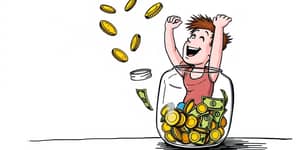In today’s fast-paced world, staying on top of your finances can feel overwhelming. Yet with the right tools, anyone can transform saving from a daunting task into an empowering journey. Visual dashboards offer an engaging way to map progress, understand spending habits, and maintain a sense of control and achievement.
The Power and Purpose of Visual Dashboards
Visual dashboards harness the brain’s preference for images, since over 90% of information processed by our minds is transformed abstract data into intuitive visuals. By compiling income, expenses, and net worth into graphs and charts, these tools condense complexity into clarity. Instead of sifting through spreadsheets or monthly statements, you encounter an immediate snapshot of your financial health.
Whether integrated into budgeting apps or standalone platforms, dashboards serve as a central command center. Users gain real-time insights on income and spending, replacing manual calculations with up-to-the-minute updates. This not only saves time but also keeps you motivated to review progress daily.
Core Benefits of Visual Dashboards for Savers
Dashboards do more than display numbers—they inspire action and accountability. Key benefits include:
- Clarity and Simplicity: Data appears in concise charts, converting raw figures into easy-to-read visuals.
- Real-Time Insights: Instant updates on cash flow, eliminating the guesswork behind account balances.
- Goal Tracking: Users can track progress towards savings goals visually through meters and progress bars.
- Immediate Feedback: Alerts and color-coded indicators highlight when you’re nearing a target or overspending.
These features work together to keep your focus sharp. Every glance at your dashboard becomes a mini pep talk, reminding you why you set goals and how far you’ve come.
Understanding the Psychology of Visualization
Visualization is a known strategy in habit formation and motivation. When you see incremental achievements, the brain releases dopamine, reinforcing the positive behavior. A dashboard that updates in real time satisfies a psychological need for feedback, making it more rewarding to log in frequently.
Behavioral economists suggest that abstract savings targets can feel distant and unrewarding. By turning those targets into visual milestones, dashboards help you anchor your ambitions in the present. Small victories—like hitting 25% of your emergency fund—become tangible, fueling a cycle of consistency and success.
Essential Elements and Metrics to Track
A well-designed finance dashboard should include the following components:
- Net Worth Over Time: A line or area chart showing assets minus liabilities.
- Monthly Savings Rate: Percentage of income saved each month, often shown as a thermometer or gauge.
- Spending Breakdown: Pie or bar charts illustrating expenses by category (e.g., groceries, entertainment, utilities).
- Goal Progress Meters: Visual trackers tied to specific objectives, such as vacations or emergency funds.
- Debt Reduction Trackers: Monitors balances on loans and credit cards, highlighting repayment milestones.
By focusing on these metrics, you build a comprehensive view of your financial journey. Each chart and graph serves as a signpost, guiding your decisions and encouraging positive habits.
Integration and Automation: Streamlining Your Dashboard
Modern dashboards excel when they sync automatically with bank accounts and investment portfolios. Automation removes the burden of manual entry, so you always have an accurate picture of your finances. Some platforms even send alerts for low balances or when unusual spending patterns appear.
Setting up integrations may require a few initial steps—linking accounts, categorizing transactions, and adjusting notification preferences. Once complete, however, your dashboard becomes a living, breathing tool that works for you around the clock.
Best Practices for Maximizing Impact
To get the most from visual dashboards, follow these guidelines:
- Review your dashboard daily to maintain awareness and momentum.
- Customize views to highlight your top motivators—whether debt payoff, retirement savings, or emergency funds.
- Use built-in goal-setting features and set alerts to enhance engagement and accountability.
- Adjust categories and chart types as your financial situation evolves.
- Share progress with an accountability partner for extra encouragement.
Regular reviews ensure you spot trends early, celebrate achievements often, and correct course when necessary.
Overcoming Challenges and Future Outlook
Even the best dashboards can fall short if they display too much information at once. Focus on the metrics that matter most to you, and collapse or remove the rest. Personalization keeps your dashboard clean and actionable.
Data security is another critical concern. Choose platforms that offer strong encryption and multi-factor authentication, safeguarding your sensitive information.
Looking ahead, expect dashboards to evolve with AI-driven insights and predictive modeling. Features like gamification and predictive analytics will evolve to provide personalized recommendations, turning saving and budgeting into engaging experiences rather than chores.
Conclusion
Visual dashboards represent a profound shift in personal finance management. By converting abstract data into dynamic, engaging visuals, these tools fuel motivation, foster accountability, and simplify decision-making.
Embrace the power of real-time insights, set clear visual goals, and witness how every small step toward your objectives becomes a source of inspiration. With a well-crafted dashboard, you’re not just tracking numbers—you’re charting a path toward financial freedom and peace of mind.
References
- https://www.eliftech.com/insights/personal-finance-dashboard-interactive-charts-performance-movers-budgeting-apps/
- https://www.domo.com/learn/article/data-visualization-dashboards
- https://policy-wizard.fas.harvard.edu/personal-finance-dashboard-excel
- https://www.sage.com/en-us/blog/why-data-visualization-is-important-for-financial-storytelling/
- https://aldertonbhudia.com/creating-a-positive-work-culture-the-key-to-effective-workforce-management
- https://www.youtube.com/watch?v=lkcJGox1d_E
- https://www.thoughtspot.com/data-trends/dashboard/financial-dashboard-examples










